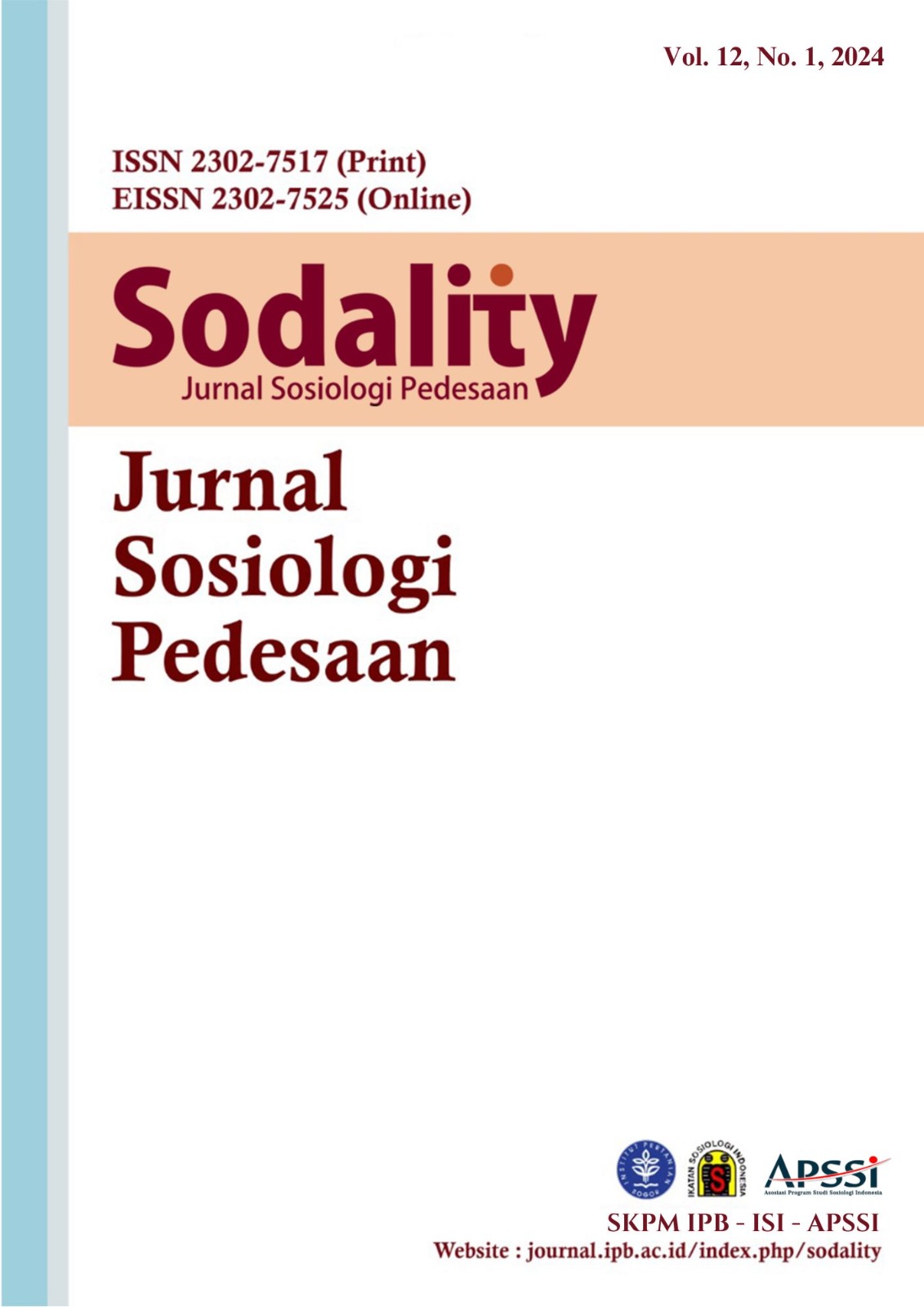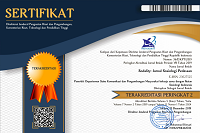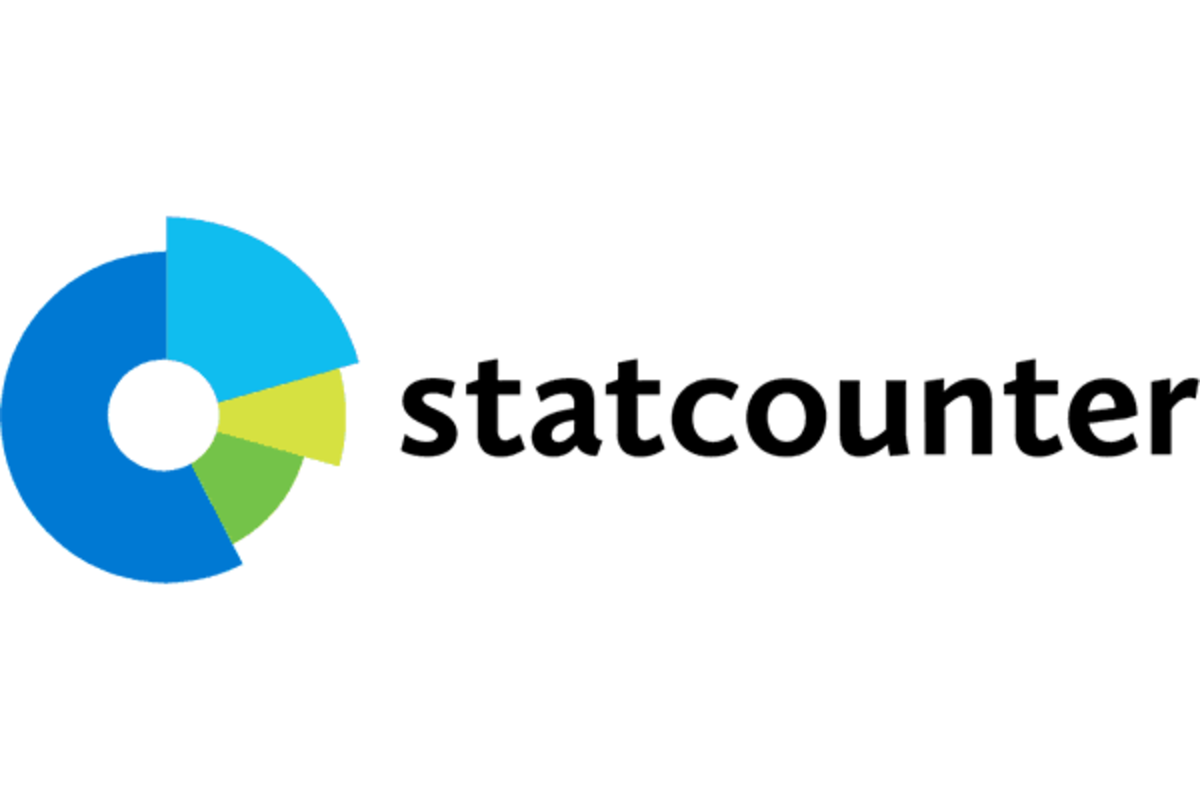Transformation of the Forestry Partnership in the Java Forest: A Study of Community Institutions Lancar Jaya after the Designation of Forest Areas with Special Management
Abstract
The Forest Village Community Institution (LMDH Lancar Jaya) is formed to carry out forestry partnerships in forest areas managed by Perum Perhutani. Along with the designation of this forest area as Forest Areas with Special Management (KHDPK), this institution and its forestry partnerships must be transformed. This study analyzes the timeline and performance of forest village community institutions to describe potential factors for the readiness of partnership transformation. Two theoretical approaches were used in this research: Situation-Structure-Behavior-Performance developed by Schmid (1987; 2004) and Jones’ organizational capacity to produce value (Jones, 2013). The method used was qualitative descriptive, timeline, and content analyses. Research data and information were collected through in-depth interviews and document analysis. This study concludes that the performance of LMDH Lancar Jaya is efficient as an independent and active institution. This performance is driven by significant capital. Good social capital is a strong network of trust in management, solid stakeholder relationships, the ability to choose institutional alternatives that suit their characteristics, minimal transaction costs, and the ability to provide market certainty with interlock transactions. This article recommends the necessary conditions for the transformation of a legal business entity by maximizing inputs for investment capacity in the form of capital, raw materials, human resources, business knowledge, and customers, which is supported by input conversion, administrative fulfillment, and cooperative facilitation of transformation.
References
Adriansen, H. K. (2012). Timeline interviews: A tool for conducting life history research. Qualitative Studies, 3(1), 40–55. https://doi.org/10.7146/qs.v3i1.6272
Affandi, O. (2019). Analisis kelembagaan implementasi perhutanan sosial di Provinsi Sumatera Utara. IPB University.
Affandi, O., Kartodihardjo, H., Nugroho, B., & Ekawati, S. (2021). Institutional analysis of forest governance after the implementation of law number 23/2014 in North Sumatra province, Indonesia. Forest and Society, 5(2), 304–325. https://doi.org/10.24259/fs.v5i2.8755
Albaniarty, G. (2018). Evaluasi ekonomi program pengelolaan hutan bersama masyarakat di Desa Ngancar, Kecamatan Ngancar, Kabupaten Kediri. IPB University.
Anggiani, P., & Hikmawan, M. D. (2022). Dinamika kemitraan antara Perum Perhutani dengan Lembaga Masyarakat Desa Hutan (LMDH) dalam pelestarian hutan mangrove di Pulo Cangkir KabupatenTangerang. Journal of Social Politics and Governance, 4(2), 112–127. https://doi.org/10.24076/jspg.v4i2.936
Bungin, B., Faisal, S., Aziz, A., Sanggar, K., Kasiyanto, & Sadewo, S. (2012). Analisis data penelitian kualitatif: pengalaman filosofis dan metodologis ke arah penguasaan model aplikasi. Raja Grafindo Persada.
FAO, & UNEP. (2020). In The State of the World’s Forests 2020. https://doi.org/https://doi.org/10.4060/ca8642en
Hart, G. (1986). Interlocking transaction obstacles, precursors or instruments of agrarian capitalism? Journal of Development Economics, 23, 177–203. https://doi.org/10.1016/0304-3878(86)90087-8
Hoff, K., & Sen, A. (2005). The Kin System as A Poverty Trap? http://econ.worldbank.org.
Jones, G. R. (2013). Organizational Theory, Design, and Change (7th ed.). Pearson Education Limited.
Kartodihardjo, H. (2017). Analisis kebijakan pengelolaan sumber daya alam diskursus-politik-aktor-jaringan. Sajogyo Institute.
Muladno, & Agatha, M. A. (2023). SPR: empowerment of smallholder livestock farmer community SPR: pemberdayaan pada komunitas peternak rakyat. Jurnal Sosiologi Pedesaan, 11(02), 143–153. https://doi.org/10.22500/11202346032
Nugroho, B. (2016). Kelembagaan, karakteristik sumberdaya, dan perilaku aktor: analisis kritis kebijakan pengelolaan hutan Indonesia. IPB University.
Ostrom, E., Gardner, R., & Walker, J. (1994). Rules, Games, And Common- Pool Resources. The University of Michigan Press.
Perhutani. (2020). Perhutani Serahkan Dana Sharing Produksi Sebesar 3,5 Milyar untuk 133 LMDH di Kediri. Perhutani.
Pramono, T., Bramantyo, R., Setiono, G., & Suwadji, S. (2019). Peningkatan Kesejahteraan Masyarakat Melalui Program Kemitraan Perhutani di Kecamatan Ngancar Kabupaten Kediri (Studi Implementasi Peraturan Menteri Lingkungan Hidup dan Kehutanan No. P. 83/MenLHK/Setjen/Kum. 1/10/2016 Tentang Kemitraan Kehutanan). Transparansi Hukum, 2(2), 122–137. https://doi.org/10.30737/transparansi.v2i2.451
Putnam, R. (1993). Making democracy work civic traditions in modern Italy. Princeton University Press.
Putnam, R. (2001). Social capital. Spring-Printemps.
Reed, M. (2019). Who‘s in and why? a typology of stakeholder analysis methods for natural resource management. Journal of Environmental Management, 90(1), 1933–1949. https://doi.org/10.1016/j.jenvman.2009.01.001
Rosyadi, S., & Sobandi, K. R. (2014). Relasi kuasa antara Perhutani dan masyarakat dalam pengelolaan hutan di Banyumas: kepentingan bisnis VS community empowerment. International Journal of Indonesian Society and Culture, 6(1), 47–56. https://doi.org/10.15294/komunitas.v6i1.2939
Rusli, T. (2017). Sistem Badan Hukum di Indonesia. AURA.
Saputra, E. R., Muttaqin, T., & Waskitho, T. N. (2019). Tingkat pendapatan anggota LMDH “Lancar Jaya” dari sektor pertanian hortikultura di Desa Ngancar Kecamatan Ngancar Kabupaten Kediri. Journal of Forest Science Avicennia, 2(1), 9–15. https://doi.org/10.22219/avicennia.v2i1.8315
Sari, M. Y. (2016). Evaluasi ekonomi program pengelolaan hutan bersama masyarakat di Desa Situraja, KPH Indramayu. IPB University.
Schmid, A. (1987). Properly, Power, and Public Choice. American Journal of Agricultural Economics, 195–196. https://doi.org/10.2307/1239528
Schmid, A. (2004). Conflict and Cooperation Institutional and Behavioral Economics. Blackwell Publishing. https://doi.org/10.1002/9780470773833.fmatter
Soedomo, S. (2016). Obroloan Nusantara: Menyambut Indonesia Baru. Firdaus.
Sunarso. (2022). Gagalnya program perhutanan sosial: studi Kasus Lmdh Ngimbang Makmur, Desa Ngimbang Kecamatan Palang, Kabupaten Tuban. Jurnal Binawakya, 16(8), 7301–7312. https://doi.org/10.33758/mbi.v16i8.1542
Sunderlin, W. D., Belcher, B., Santoso, L., Angelsen, A., Burgers, P., Nasi, R., & Wunder, S. (2005). Livelihoods, forests, and conservation in developing countries: An overview. World Development, 33(9 SPEC. ISS.), 1383–1402. https://doi.org/10.1016/j.worlddev.2004.10.004
Zain, M., Soeaidy, S., & Mindarti, L. (2021). Kemitraan antara KPH perhutani dan LMDH dalam menjaga kelestarian hutan (Studi pada Desa Jengglungharjo Kecamatan Tanggunggunung Kabupaten Tulungagung. Jurnal Administrasi Publik, 2(2), 210–216.
Authors who publish with this journal agree to the following terms:
- Authors retain copyright and grant the journal right of first publication with the work simultaneously licensed under a

This work is licensed under a Creative Commons Attribution 4.0 International License. that allows others to share the work with an acknowledgement of the work's authorship and initial publication in this journal. - Authors are able to enter into separate, additional contractual arrangements for the non-exclusive distribution of the journal's published version of the work (e.g., post it to an institutional repository or publish it in a book), with an acknowledgement of its initial publication in this journal.
- Authors are permitted and encouraged to post their work online (e.g., in institutional repositories or on their website) prior to and during the submission process, as it can lead to productive exchanges, as well as earlier and greater citation of published work (See The Effect of Open Access).





.png)









